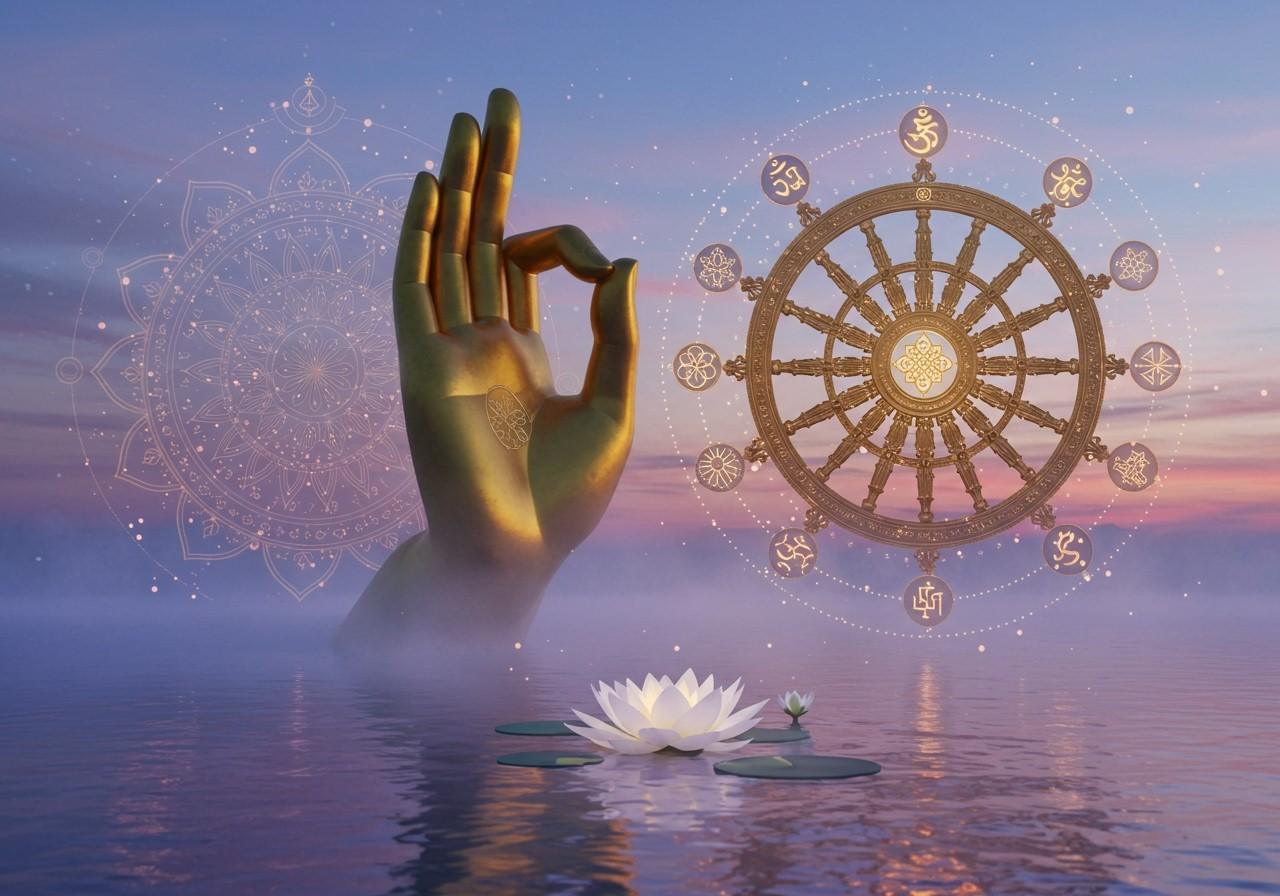
Buddhism, a rich and ancient spiritual tradition, is replete with symbolism. These symbols are not mere decorations; they embody profound teachings and philosophies. This guide delves into the meanings of various Buddhist symbols, exploring their significance and use within the Buddhist tradition. This exploration is particularly relevant for culturally rooted, middle to upper-middle-class Indians who appreciate tradition and seek authentic ritual items with the convenience of online shopping.
The Eight Auspicious Symbols (Ashtamangala)
The Ashtamangala, a collection of eight sacred emblems, holds deep reverence in Buddhism. These symbols frequently appear in ceremonies, artwork, and various forms of Buddhist expression.
- The Parasol (Chattra): A symbol of protection from harmful forces, the parasol also represents royalty, honor, and spiritual dominion. It signifies the expansive shelter of Buddhist teachings shielding followers from suffering.
- The Golden Fish (Suvarnamatsya): Representing happiness, fertility, and abundance, the golden fish symbolize liberation from suffering and the ability to navigate the waters of life with ease. They are often depicted swimming freely, symbolizing spiritual freedom.
- The Treasure Vase (Kalasha): The treasure vase symbolizes inexhaustible wealth, both material and spiritual. It signifies the boundless blessings of the Dharma and the potential for spiritual fulfillment.
- The Lotus Flower (Padma): A quintessential symbol of purity, enlightenment, and rebirth, the lotus flower emerges pristine from muddy waters. It embodies the potential for spiritual growth amidst the challenges of life.
- The Conch Shell (Shankha): Symbolizing the spread of the Buddha’s teachings and the resonant sound of the Dharma, the conch’s call awakens practitioners to the truth and dispels ignorance.
- The Endless Knot (Shrivatsa): Representing the interconnectedness of all things and the endless cycle of life, death, and rebirth, the endless knot symbolizes the intricate web of cause and effect.
- The Victory Banner (Dhvaja): Signifying the triumph of the Buddha’s teachings over ignorance and suffering, the victory banner represents the victory of wisdom and compassion over negativity.
- The Wheel of Dharma (Dharmachakra): Representing the teachings of the Buddha and the path to enlightenment, the Dharmachakra’s eight spokes symbolize the Noble Eightfold Path, the core principles guiding Buddhist practice.
Other Important Buddhist Symbols
Beyond the Ashtamangala, numerous other symbols hold profound meaning in Buddhism.
- The Buddha Statue: Representing the historical Buddha, Siddhartha Gautama, these statues serve as a focal point for reverence and contemplation of his teachings. They inspire practitioners to cultivate wisdom, compassion, and mindfulness.
- The Bodhi Tree: Symbolizing the place where the Buddha attained enlightenment, the Bodhi tree represents the potential for awakening within each individual. It is a reminder of the transformative power of meditation and mindful awareness.
- The Stupa: A mound-like structure containing relics, stupas serve as places of meditation and symbolize the enlightened mind. They represent the Buddha’s presence and the potential for enlightenment within all beings.
- The Vajra: Symbolizing the indestructible nature of truth and the unwavering firmness of spirit, the vajra represents the power of wisdom to cut through delusion.
- The Bell (Ghanta): Representing wisdom and the feminine aspect of the divine, the bell’s clear tone symbolizes the clarity of understanding that arises through practice. It is often used in rituals and meditations.
- The Mandala: A geometric representation of the universe, the mandala serves as a tool for meditation and visualization. It represents the interconnectedness of all things and the journey towards spiritual wholeness.
- The Swastika: An ancient symbol of good fortune, the swastika has been tragically misappropriated in modern times. In its original Buddhist context, it represents auspiciousness, peace, and well-being.
Where to Find Authentic Buddhist Symbols and Statues
For those seeking authentic Buddhist ritual items, Poojn.in offers a curated collection of genuine pieces for your spiritual practice. Our selection includes meticulously crafted Buddha statues and sacred symbols imbued with deep meaning within Buddhist traditions.
The Lord Buddha Marble Dust Idol (15 cm) available on our site is hand-crafted with meticulous attention to detail, making it a perfect addition to home shrines or meditation spaces. Other items can also enhance your sacred space.
Buddhist symbols contribute to a serene ambiance and serve as potent reminders of the Buddha’s teachings. At Poojn.in, we ensure each item adheres to traditional specifications while remaining accessible. The marble dust Buddha statue, for instance, embodies the classic meditation pose, representing peace and enlightenment.
Conclusion
Understanding Buddhist symbols unlocks a gateway to the profound wisdom and rich traditions of this ancient path. These symbols, from the Ashtamangala to the intricate mudras and vibrant colors, are more than mere images; they are powerful tools that enrich spiritual practices and daily life. For culturally rooted individuals who value tradition, these symbols offer a tangible connection to Buddhist teachings while embracing the convenience of online shopping.
By incorporating these symbols into your rituals, meditation, and daily life, you connect with a heritage spanning millennia, inviting peace, protection, and enlightenment into your home. Each symbol carries its unique significance and power, guiding you on your spiritual journey.


